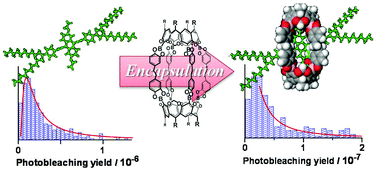Enhanced photostability of an anthracene-based dye due to supramolecular encapsulation: a new type of photostable fluorophore for single-molecule study†
Abstract
For single-molecule fluorescence studies, highly photostable fluorophores are absolutely imperative, because photo-induced degradation (i.e., photobleaching) limits the observation time of individual molecules. Herein, the photophysics and photostability of a highly fluorescent 9,10-bis(phenylethynyl)anthracene derivative (G) and its self-assembled boronic ester encapsulation complex (G@Cap) embedded in a glassy polymer matrix are investigated by single-molecule fluorescence spectroscopy (SMFS). The heterogeneity of the fluorescence emission wavelength and triplet blinking kinetics of the guest G are significantly decreased by supramolecular encapsulation due to conformational restriction and reduced heterogeneity in the local environment. A nearly 10-fold increase in the photostability of G due to encapsulation is quantitatively confirmed by evaluating the photobleaching yields of G and G@Cap. In addition, it is found that the G@Cap is >30-fold more photostable than rhodamine 6G, a widely used fluorescent dye in single-molecule studies. These results demonstrate that the G@Cap can serve as a very bright, long-lasting fluorescent probe for single-molecule studies.


 Please wait while we load your content...
Please wait while we load your content...